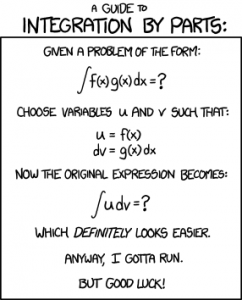xkcd beklagt sich gestern darüber, dass man in der Mathematik manchmal Ideen brauche, welche nicht einfach in feste Regeln zu fassen sind:

Als Hintergrundtext:
If you can manage to choose u and v such that u = v = x, then the answer is just \((1/2)x^2\), which is easy to remember. Oh, and add a '+C' or you'll get yelled at.
'integration by parts' (deutsch: 'partielle Integration') ist das Ausnutzen der Formel \(\int udv =uv - \int vdu\). Man braucht natürlich die richtige Intuition (oder vielleicht eher Geduld), um geeignete \(u\) und \(v\) zu finden, mit denen sich die rechte Seite dann berechnen läßt. Mit \(u=v=x\) bekommt man \(\int xdx = x^2-\int xdx\), also \(\int xdx =\frac{1}{2}x^2\).
Das erinnert an die bekannte Geschichte von Lord Kelvin (aus S.P. Thompson, The Life of Lord Kelvin, Chelsea Publishing, 2000):
Once when lecturing in class, Lord Kelvin used the word mathematician and then interrupting himself asked his class: ‘Do you know what a mathematician is?’ Stepping to his blackboard he wrote upon it:
\(\int_{-\infty}^\infty e^{-x^2}dx=\sqrt{\pi}\)
Then putting his finger on what he had written, he turned to his class and said, ‘a mathematician is one to whom that is as obvious as that twice two makes four is to you.
Das funktioniert im Prinzip genauso wie die von xkcd vorgeschlagene Berechnung von \(\int xdx\) (nur dass statt des Doppelten das Quadrat integriert wird und man deswegen nicht einmal mehr partielle Integration braucht), nämlich:
\((\int_{-\infty}^\infty e^{-x^2}dx)^2\\
=(\int_{-\infty}^\infty e^{-x^2}dx)(\int_{-\infty}^\infty e^{-y^2}dy)\\
= \int_{-\infty}^\infty\int_{-\infty}^\infty e^{-x^2-y^2}dxdy\\
= \int_0^{2\pi}\int_0^\infty e^{-r^2} rdrd\theta\\
= 2\pi \int_0^\infty r e^{-r^2} dr\\
= 2\pi (\lim_{r\rightarrow\infty}\frac{-e^{-r^2}}{2}-(\frac{-e^0}{2}))\\
=\pi\).
 Als Hintergrundtext:
Als Hintergrundtext:


